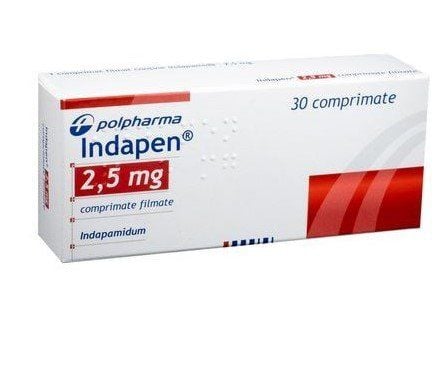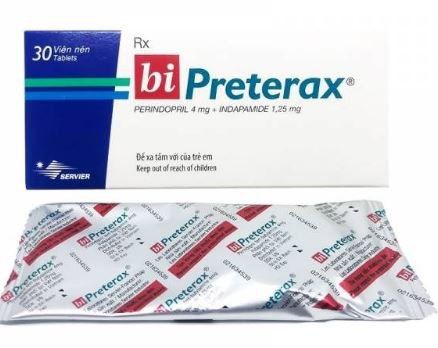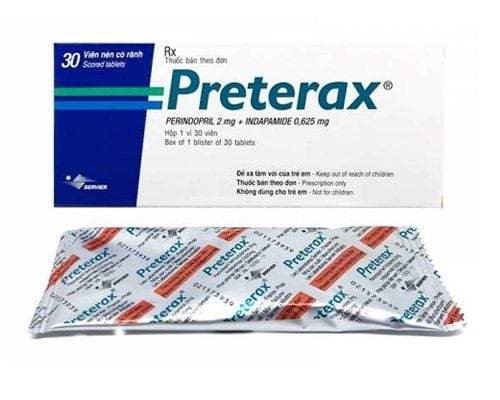This is an automatically translated article.
Indatab P is an antihypertensive drug with the main ingredients Perindopril erbumine 4mg and Indapamide USP 1.25mg. Below is detailed information about the drug Indatab P has what effect and note when using.
1. What is Indatab P?
Each Indatab P tablet contains the main ingredient Perindopril erbumine Ph.Eur 4mg + Indapamide USP 1.25mg.
Perindopril erbumine/ Indapamide 4/1.25 is a combination of the angiotensin converting enzyme (ACE) inhibitor perindopril erbumine and indapamide - the diuretic Chlorosulphamoyl. In particular, the dose of the combination of ACE inhibitors and diuretics is 2 times lower than the usual single dose.
2. Indications of the drug Indatab P
Indatab P is used to treat high blood pressure. Do not initiate treatment with Indatab P .
3. Contraindications of Indatab P
Indatab P is contraindicated in the following subjects:
Patients with hypersensitivity to Perindopril or Indapamide or any component of the combination tablet Perindopril erbumine/ Indapamide 4/1.25. Pregnant and lactating women. Patients with severe renal impairment (creatinine clearance less than 30 mL/min, untreated severe heart failure. Patients with single or double renal artery stenosis. Family history and/or idiopathic or related angioedema). The use of ACE inhibitors Patients on hemodialysis who are taking polyacrylonitrile hemolytic plaques are likely to experience hypersensitivity reactions if they are treated with ACE inhibitors. Either this or another antihypertensive drug must be selected History of hypersensitivity to sulphonamides Dysuria, progressive and severe oliguria, hepatic encephalopathy, severe hepatic impairment, hypokalemia and concomitant use of other antihypertensive agents. antiarrhythmic causing torsade de pointes.
4. Dosage of Indatab P
Dosage: Take a single tablet a day, take it in the morning.
Elderly: Renal failure commonly occurs in the elderly. Caution should be exercised when prescribing drugs containing perindopril to the elderly with hypertension. The starting dose in the elderly is 1 tablet of Perindopril 2mg/Indapamide 0.625mg/day. Patients should be closely monitored in the early stages of treatment.
Particular caution should be exercised in elderly patients with congestive heart failure with impaired renal and hepatic function.
Patients with renal impairment: Do not use the drug for patients with severe renal impairment (creatinine clearance less than 30mL/min). In patients with moderate renal impairment (clearance 30-60mL/min), the maximum dose is 1 tablet of Perindopril 2mg/Indapamide 0.625mg/day. No dose adjustment is required in patients with creatinine clearance greater than 60 mL/min.
Other dangerous situations:
In patients with severe heart failure (grade IV) or insulin-dependent diabetes (with a tendency to spontaneously increase potassium levels), the dose should be reduced at the start of treatment and should be Check with caution during this period. Usage: Indatab P is taken orally.
5. Side effects of Indatab P
Indatab P may cause some unwanted effects such as fatigue, dizziness, headache, sleep disturbance, cramps, orthostatic hypotension.
6. Be careful when using Indatab P
Should be used with caution in patients with renal impairment and at risk of hypotension and metabolic imbalance. The possibility of a decrease in the concentration of potassium attack, especially in patients with renal impairment, cannot be excluded when perindopril and indapamide are used together. As with other antihypertensive agents containing diuretics, plasma potassium levels should be regularly monitored. Elderly: Renal failure commonly occurs in the elderly. Caution should be exercised when prescribing drugs containing perindopril to the elderly with hypertension. The starting dose in the elderly is Perindopril 2mg/Indapamide 0.625mg per day. Patients should be closely monitored in the early stages of treatment. Fluid and Electrolyte Imbalances: Patients should be managed for signs and symptoms of fluid or electrolyte imbalance, hyponatremia/hyperchloremia, uremia, and hyperkalemia and hypokalemia. It is necessary to monitor plasma urea and uric acid levels during treatment. Clinical features of electrolyte imbalance include dry mouth, thirst, weakness, lethargy, fatigue, restlessness, myalgia, cramps, muscle fatigue, decreased blood pressure, urinary frequency, and gastrointestinal disturbances. such as vomiting and nausea, tachycardia, ECG changes. Hyperkalemia: People with diabetes and especially the elderly may be at risk for hyperkalemia. However, hyperkalemia (>5.5 mmol/L) is more likely to occur in patients with acute renal failure or in patients who have been treated with potassium diuretics or potassium supplements and/or saline. contains potassium. In some patients, hyponatremia may also occur with hypokalemia. Angioedema: Serious life-threatening angioedema has also been reported in some cases with ACE inhibitors. Hypotension: Hypotension may be reported in patients initiating treatment with an ACE inhibitor. Excessive reduction in blood pressure has rarely been reported in uncomplicated hypertension, likely related to the use of perindopril in severely volume-depleted patients with pre-existing renal impairment. intensive treatment with diuretics after severe diarrhea or in patients on dialysis. Renal Impairment: As with renin-angiotensin-aldosterone system (RAAS) inhibitors, changes in renal function were evaluated in individual patients. Patients with severe congestive heart failure whose renal function is dependent on RAAS activity, anuria and/or progressive azotemia and, rarely, acute renal failure and/or death may be associated with treatment with ACE inhibitors. ACE inhibitors should be avoided in patients with known or suspected renal artery stenosis. Acute renal failure may occur with the use of ACE inhibitors in patients with single or double renal artery stenosis. Hepatic impairment: The biotransformation of perindopril to perindoprilat occurs primarily in the liver. Studies in patients with hepatic impairment have shown that the pharmacokinetic parameters of perindopril are not altered by hepatic impairment. Regardless of the increased bioavailability, the pharmacokinetic parameters of perindoprilat (including Tmax) were unchanged. The increased bioavailability may be due to inhibition of the formation of the perindopril metabolite rather than to perindoprilat. Administration of perindopril leads to the formation of the glucuronocon-linked derivative of perindoprilat by effect of first-pass metabolism in the liver. The pharmacokinetic parameters of perindoprilat glucuronide were not affected by hepatic impairment. Severe heart failure (grade IV): Patients with severe heart failure (grade IV) need to be closely monitored during the initial phase of treatment. The initial dose should be reduced. There is no need to discontinue therapy with beta-channel blockers in hypertensive patients with coronary insufficiency; ACE inhibitors can be added. Patients with insulin-dependent diabetes: In patients with insulin-dependent diabetes (with a tendency to spontaneously increase potassium levels), the dose should be reduced at the start of treatment and caution should be exercised during this period. Cough: Irritation of a persistent dry cough has been reported with most ACE inhibitors. Cough is often worse when lying down or at night, occurring more often in women (accounting for up to two-thirds of reported cases). Pregnancy and breast-feeding: Because the drug contains a combination of ACE inhibitors, Perindopril erbumine/Indapamide 4/1.25 should not be used in pregnant women. Animal studies have shown that perindopril and its metabolites are secreted into breast milk during lactation; however, there are no human data. It is not known whether Indapamide is excreted in milk. Therefore, the combined use of Perindopril erbumine/Indapamide 4/1.25 in nursing mothers is not recommended because the effect of the drug on the infant is unknown. The use of Perindopril erbumine/Indapamide 4/1.25 in children is not recommended for children because there are no adequate and safe data in this population. The article has provided information about the uses, doses and precautions when using Indatab P. To ensure safety for your health and maximize the effectiveness of your treatment, you need to take Indatab P exactly as directed by your doctor.
Please dial HOTLINE for more information or register for an appointment HERE. Download MyVinmec app to make appointments faster and to manage your bookings easily.













